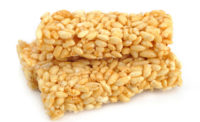High-Protein Synergies
Formulators, chefs combine talents to deliver high protein with optimum taste

In today’s market, product developers are constantly challenged with creating more nutritious foods while satisfying consumers’ taste expectations. One of those key expectations is to include more protein in formulations. An approach that has proven successful in many high-protein formulations is blending proteins to achieve target protein levels and great taste.
Through blending, formulators can take advantage of the flavor and nutritional synergies that often result. Understanding the flavor and functional advantages and disadvantages of individual proteins within a blend is critical in developing an optimal protein blend.
Several trends underscore the importance of continued innovation in protein-rich foods and beverages, including increased consumer interest in higher protein foods for weight management, and muscle growth and development. That interest spans many consumer groups, including aging consumers who can benefit from increased protein intake; healthy, active consumers; and moms concerned with providing foods that help to meet nutrient intake targets for their children’s diets.
Proteins on Demand
Dairy and soy proteins are widely used in high protein foods and beverages for a good reason: These protein sources blend well together, and food developers are discovering there are substantial benefits from blending soy and dairy ingredients to develop creative new formulations that have the natural taste and texture appeal consumers desire.
Both dairy and soy bring individual strengths and flavor attributes to a particular formulation. An “ideal” blend of the two depends on what the culinologist is trying to achieve. To optimize a blend, food developers and ingredient technologists can work together to assess the value each ingredient contributes to the end product and how best to leverage the combination.
Soy protein remains an ideal vegetable protein to utilize in that it is one of the only widely available plant proteins also classified as a high-quality protein. In the continued merging of health and cuisine, product creators can rely on years of clinical research that underscore the heart and other health benefits of soy. It also is the only protein source with an FDA-approved health claim recognizing those benefits.
In development, soy protein is often used because of its low-fat/low saturated-fat/zero-cholesterol profile. It also is considered a source of sustainable protein, requiring less land, water and resources to produce, compared to animal-based proteins. In addition to offering substantial nutritional benefits, soy protein provides useful properties for food manufacturers, such as emulsification, gelation and “whipability.”
Dairy proteins are also considered complete, containing all the essential amino acids required to be regarded as high-quality proteins. On the health side, isolated dairy proteins, specifically whey and casein, have a high content of branched-chain amino acids. These protein building blocks are known for the ability to trigger a pathway responsible for synthesis of muscle proteins.
Whey has a rapid digestion rate and contains a higher percentage of the essential amino acid leucine at the expense of other essential and non-essential amino acids. Alternately, casein has a slow digestion rate which can be beneficial for reducing muscle breakdown. For formulators making sports and recovery bars and beverages, these are ideal.
The Blended Family
The opportunities for blending soy and dairy ingredients are enormous, and the benefits are significant. In health-oriented products, a functional blend of soy and dairy can capitalize on the unique properties of the individual proteins and allow for optimal delivery of amino acids to the body.
When it comes to flavor challenges, soy and dairy protein blends have versatility for food and beverage makers. It is not always easy to deliver high protein and great taste. In many applications, soy-dairy blends can deliver preferred flavor profiles that play off each other or balance out any undesired protein flavor notes, compared to foods and beverage formulated with either all dairy or all soy proteins. This translates to greater consumer acceptance of the end product’s flavor.
Soy and dairy protein combinations in nutrition bars can favorably impact flavor, shelflife and cost. If the soy-dairy proteins are formulated optimally, it is possible to reduce costs of formulation, extend shelflife and boost flavor. Specially designed soy proteins have been created to provide these benefits in nutrition bar applications.
Soy, being a highly available protein source, is also increasingly relied on to attain higher protein levels in traditionally dairy-oriented nutritional beverages. With the overall demand for protein increasing and the price for dairy protein rising, soy protein is becoming an obvious choice for blending with dairy in beverages.
There are a number of ingredient considerations for beverage development. For a dry-blended beverage, the developer might need an instant protein, a non-hydroscopic product or an ingredient that disperses easily in cold or hot water. Proprietary dry blended soy/whey blends work perfectly in such drinks. When created specifically for beverages, this kind of blend will ideally be highly dispersible and easily hydrated, deliver a smooth mouthfeel and creamy texture.
The dry blended soy/whey blends are not only ideal for beverages but also for yogurt-type products. They make a great alternative to whole milk or skim milk powder and provide high-quality protein nutrition for products designed for children, adults and seniors.
Isolated soy proteins, which are at least 90% protein on a moisture-free basis, also are quite versatile in beverage applications. They, too, provide cost benefits compared to dairy proteins such as caseinates, milk protein concentrates and isolates, as well as whey protein concentrates and isolates. Used in combination with these proteins in beverage formulations, developers can not only reduce protein costs, but also create improved flavor profiles for end products.
Bars & Baked Goods
One of the most popular applications for combining soy and dairy proteins is in nutrition bars. According to SymphonyIRI Group, nutrition bars supplied 57% of dollar sales in the overall food bar category, compared to breakfast bars at only 26% and granola bars at 17%. And, for bar makers, high-protein bars in general add up to nearly 40% of all bar sales.
Protein-containing bars can serve as snacks or meal substitutes, giving general consumers and athletes a healthful option to get them through a busy day and help manage hunger through whatever may lie ahead on their schedule, be it the next meeting or the next workout. Select blended soy-dairy proteins can also enhance the marketing message on a product. For example, adding sufficient soy (at least 6.25 g), as part of a product that is low in cholesterol, sodium, total and saturated fat may make it eligible for the use of a heart-health claim.
Baked goods are another application area that frequently utilizes a blend of soy and dairy ingredients. Recent trends point to more nutritionally dense bakery products, including high-protein baked snack foods, breads and cakes. Baked goods with high protein content and controlled carbohydrates can be formulated to have a low glycemic index (GI). Low-GI diets are followed by those who wish to manage their blood glucose levels, currently a large consumer demographic and one that can pose flavor and texture culinary challenges.
Stabilization of these protein blend products can also be challenging, especially when considering the forces of heat and pressure involved in baking. Identifying the ideal combination of proteins and hydrocolloids is critical to maintaining a high-quality, tasty and desirable product throughout its intended shelflife.
For culinologists, working in tandem with a supplier who has strong technical capabilities and formulation knowledge in high-protein foods can be important to achieving formulation objectives. Taking advantage of such expertise also has the advantage of accelerating product-development timelines.
New Product Possibilities
In addition to the consumer demographics of children, seniors, athletes and active Baby Boomers, there are a number of formulation and market opportunities for foods and beverages using soy and dairy protein blends. The market for products that deliver benefits ranging from satiety, heart health or just provide nutrition support consistent with an overall healthy lifestyle are growing daily.
One example is that of creating high-protein products that are formulated to deliver satiety, manage hunger and calorie intake to combat obesity. And, for the rapidly expanding population of seniors, products can be formulated to support muscle maintenance or help mitigate the muscle loss of aging. Muscle loss in aging is of special concern to women, who seem to experience it from an earlier onset and in many cases more severely than men. For active, healthy individuals, higher protein foods can help them achieve their personal health and fitness goals.
High-protein products have gained significant market share over the last several years. Their health appeal is particularly attractive to today’s consumer, while the technical expertise in formulating with blends of proteins has greatly advanced the ability to deliver against consumers’ taste expectations.
Each type of protein—soy or dairy—provides specific functional and nutritional properties that the food developer can use in the creative process. All food and beverages succeed or fail on the basis of their flavor quality and appeal. Selecting the right blend can mark the difference between success and failure.
Looking for a reprint of this article?
From high-res PDFs to custom plaques, order your copy today!





